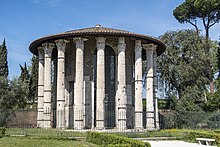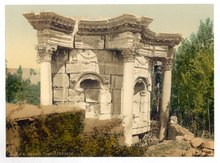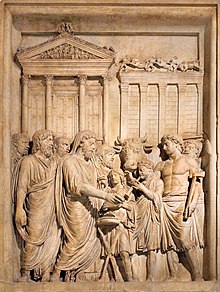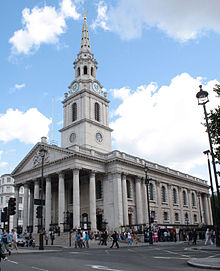Roman temple


Ancient Roman temples were among the most important buildings in
The most common architectural plan had a rectangular temple raised on a high
Public religious ceremonies of the official
Some remains of many Roman temples still survive, above all in Rome itself, but the relatively few near-complete examples were nearly all converted into Christian churches (and sometimes subsequently to
Terms
The English word "temple" derives from the Latin templum, which was originally not the building itself, but a sacred space surveyed and plotted ritually.[6] The Roman architect Vitruvius always uses the word templum to refer to the sacred precinct, and not to the building. The more common Latin words for a temple or shrine were sacellum (a small shrine or chapel), aedes, delubrum, and fanum (in this article, the English word "temple" refers to any of these buildings, and the Latin templum to the sacred precinct).
Architecture
The form of the Roman temple was mainly derived from the

Etruscan and Roman temples emphasised the front of the building, which followed

The platform on which the temple sat was typically raised higher in Etruscan and Roman examples than Greek, with up to ten, twelve or more steps rather than the three typical in Greek temples; the Temple of Claudius was raised twenty steps. These steps were normally only at the front, and typically not the whole width of that. It might or might not be possible to walk around the temple exterior inside (Temple of Hadrian) or outside the colonnade, or at least down the sides.[10] The description of the Greek models used here is a generalization of classical Greek ideals, and later Hellenistic buildings often do not reflect them. For example, the "Temple of Dionysus" on the terrace by the theatre at Pergamon (Ionic, 2nd century BC, on a hillside), had many steps in front, and no columns beyond the portico.[11] The Parthenon, also approached up a hill, probably had many wide steps at the approach to the main front, followed by a flat area before the final few steps.[12]
After the eclipse of the Etruscan models, the Greek
The front of the temple typically carried an inscription saying who had built it, cut into the stone with a "V" section. This was filled with brightly coloured paint, usually scarlet or
Sculptural decoration was similar to that of Greek temples, often with
There was considerable local variation in style, as Roman architects often tried to incorporate elements the population expected in its
Circular plans

Romano-Celtic temples were often circular, and circular temples of various kinds were built by the Romans. Greek models were available in
Different formulae were followed in the
At
Caesareum
A caesareum was a temple devoted to the
In the city of Rome, a caesareum was located within the religious precinct of the
One of the earliest and most prominent of the caesarea was the
Temple of Jupiter Optimus Maximus

The Temple of Jupiter Optimus Maximus on the Capitoline Hill was the oldest large temple in Rome, a capitolium dedicated to the Capitoline Triad consisting of Jupiter and his companion deities, Juno and Minerva, and had a cathedral-like position in the official religion of Rome. It was destroyed by fire three times, and rapidly rebuilt in contemporary styles. The first building, traditionally dedicated in 509 BC,[23] has been claimed to have been almost 60 m × 60 m (200 ft × 200 ft), much larger than other Roman temples for centuries after, although its size is heavily disputed by specialists. Whatever its size, its influence on other early Roman temples was significant and long-lasting.[24] The same may have been true for the later rebuildings, though here the influence is harder to trace.
For the first temple Etruscan specialists were brought in for various aspects of the building, including making and painting the extensive terracotta elements of the entablature or upper parts, such as antefixes.[25] But for the second building they were summoned from Greece. Rebuildings after destruction by fire were completed in 69 BC, 75 AD, and in the 80s AD, under Domitian – the third building only lasted five years before burning down again. After a major sacking by Vandals in 455, and comprehensive removal of stone in the Renaissance, only foundations can now be seen, in the basement of the Capitoline Museums.[26] The sculptor Flaminio Vacca (d 1605) claimed that the life-size Medici lion he carved to match a Roman survival, now in Florence, was made from a single capital from the temple.[27]
Influence

The Etruscan-Roman adaptation of the Greek temple model to place the main emphasis on the front façade and let the other sides of the building harmonize with it only as much as circumstances and budget allow has generally been adopted in
Variations on the theme, mostly Italian in origin, include:
An archetypical pattern for churches in

Examples of modern buildings that stick more faithfully to the ancient rectangular temple form are only found from the 18th century onwards.[1] Versions of the Roman temple as a discrete block include La Madeleine, Paris (1807), now a church but built by Napoleon as a Temple de la Gloire de la Grande Armée ("Temple to the Glory of the Great Army"), the Virginia State Capitol as originally built in 1785–88, and Birmingham Town Hall (1832–34).[32]
Small Roman circular temples with colonnades have often been used as models, either for single buildings, large or small, or elements such as domes raised on drums, in buildings on another plan such as
Though the Pantheon's large circular domed cella, with a conventional portico front, is "unique" in Roman architecture, it has been copied many times by modern architects. Versions include the church of
Substantial survivals



Most of the best survivals had been converted to churches (and sometimes later mosques), which some remain. Often the porticos were walled in between the columns, and the original cella front and side walls largely removed to create a large single space in the interior. Rural areas in the Islamic world have some good remains, which had been left largely undisturbed. In Spain some remarkable discoveries (Vic, Cordoba, Barcelona) were made in the 19th century when old buildings being reconstructed or demolished were found to contain major remains encased in later buildings. In Rome, Pula, and elsewhere some walls incorporated in later buildings have always been evident. The squared-off blocks of temple walls have always been attractive for later builders to reuse, while the large pieces of massive columns were less easy to remove and make use of; hence the podium, minus facing, and some columns are often all that remain. In most cases loose pieces of stone have been removed from the site, and some such as capitals may be found in local museums, along with non-architectural items excavated, such as terracotta
- Rome
- Pantheon or Temple to All The Gods, unique among Roman temples, but later much imitated. Easily the most impressive and complete interior to survive.
- Temple of Hercules Victor, early circular temple, largely complete
- Temple of Portunus or "Temple of Fortuna Virilis" – very complete Ionic exterior, near Santa Maria in Cosmedin and the Temple of Romulus
- Temple of Romulus – very complete circular exterior, early 4th century, Roman Forum
- Temple of Antoninus and Faustina – the core of the building survives as a church, including parts of the frieze, Roman Forum
- Temple of Hadrian – Campus Martius – a huge wall with 11 columns, now incorporated in a later building
- Temple of Vesta – small circular temple, part complete, Roman Forum
- Temple of Saturn – 8 impressive columns and architrave remain standing, west end of the Roman Forum
- Temple of Bellona (Ostia)– small back-street all-brick temple at the port.
- Elsewhere
- Palestrina, Sanctuary of Fortuna Primigenia, (see above) a large complex leading to a small shrine
- Temple of Apollo (Pompeii), unusually, it is the smaller elements that are best preserved, and the surrounding forum
- Tivoli, so-called, circular
- Capitolium of Brixia, Brescia, buried by a landslide and partly reconstructed
- Southern France, one of the most complete survivals
- Temple of Augustus and Livia – Vienne, France, exterior largely complete
- , largely complete (illustrated above); a large wall from another temple forms part of the town hall next door.
- Roman Temple of Évora – Évora, Portugal, impressive partial remains of a small temple; podium and columns, but no cella.
- Temple of Jupiter in Diocletian's Palace, Split, Croatia. Small but very complete, amid other Roman buildings, c. 300. Most unusually, the barrel ceiling is intact.
- Roman temple of Alcántara, Spain, tiny but complete
- Roman temple of Vic, Spain. Substantially rebuilt, after it was found covered by a castle.
- Roman temple of Córdoba, Spain. Base and 11 Corinthian columns, found inside later buildings.
- Temple of Bacchus, Baalbek, Lebanon, a famous exotic "Baroque" pilgrimage destination, very largely preserved, including the interior.[38]
- Temples of Jupiter and Venus, Baalbek
- Temple of Artemis (Jerash), Jordan; partial remains of two other temples
- Sbeitla, Tunisia, three small temples in a row on the forum, many other city ruins.
- Dougga, Tunisia, several temples in extensive city ruins, two with substantial remains.

See also
- List of Ancient Greek temples
- Temple for other religious traditions
Notes
- ^ a b Summerson (1980), 25
- ISBN 0674015177.
- ISBN 0567089436.
- ^ a b Sear
- ^ Wheeler, 104–106; Sear
- ^ Stamper, 10
- ISBN 978-0-582-73984-0.
- ^ Boardman, 255; Henig, 56
- ^ Wheeler, 89; Henig, 56
- ^ Henig, 56, Wheeler, 89
- ISBN 0140218661
- ^ 16 in a reconstruction drawing by G. Stephens, p. 38 in The Acropolis: Monuments and Museum, by G. Papathanassopoulos, Krene Editions, 1977
- ^ Summerson (1980), 8–13
- ^ Henig, 225
- ^ Strong, 47-48
- ^ Henig, 56–57; Wheeler, 100–104: Sear
- ^ Wheeler, 100–104; Sear
- ^ Wheeler, 97–106, 105 quoted. Originally, the "uncomfortable" junction was screened by a wall and less apparent.
- ^ Boardman, 256–257
- ^ Henig, 55; Sear
- ^ The statues are all lost, but the base for the statue of Marcus Aurelius survives, and the inscriptions of seven of the nine are recorded in volume 6 of the Corpus Inscriptionum Latinarum. Jane Fejfer, Roman Portraits in Context (Walter de Gruyter, 2008), p. 86.
- ^ David M. Gwynn, "Archaeology and the 'Arian Controversy' in the Fourth Century," in Religious Diversity in Late Antiquity (Brill, 2010), p. 249.
- Ab urbe condita, 2.8
- ^ Stamper, 33 and all Chapters 1 and 2. Stamper is a leading protagonist of a smaller size, rejecting the larger size proposed by the late Einar Gjerstad.
- ^ Stamper, 12–13
- from A Topographical Dictionary of Ancient Rome, by Samuel Ball Platner (as completed and revised by Thomas Ashby), Oxford University Press, 1929
- ^ Stamper, 15
- The Financial Times, January 25, 2013
- ISBN 0674035720, 9780674035720, google books
- ^ Summerson (1980), captions to illustrations 21, 41, 42, 72–75
- ^ Summerson (1988), 64–70
- ^ Summerson (1980), 28. The Virginia State Capitol is specifically based on the Maison carre, but in a cheaper Ionic rather than Corinthian.
- ^ Summerson (1980), 25, 41–42, 49–51
- ^ Summerson (1980), 38–39, 38 quoted
- ^ Summerson (1980), 38–39
- ^ Vickers, Michael, Ancient Rome, Preface, 1989, Elsevier-Phaidon; Henig, 191–199
- ^ Strong, 48
- ^ Wheeler, 93–96
- ^ Tacitus. Annales. II.49.
References
- "EERA" = ISBN 0300052901, 9780300052909, google books
- Henig, Martin (ed.), A Handbook of Roman Art, Phaidon, 1983, ISBN 0714822140
- Sear, F. B., "Architecture, 1, a) Religious", section in Diane Favro, et al. "Rome, ancient." Grove Art Online. Oxford Art Online. Oxford University Press, accessed March 26, 2016, subscription required
- Stamper, John, The architecture of Roman temples: the republic to the middle empire, Cambridge University Press, 2005
- Strong, Donald, et al., Roman Art, 1995 (2nd edn.), Yale University Press (Penguin/Yale History of Art), ISBN 0300052936
- ISBN 0-500-20177-3
- ISBN 0712620958. (Also see revised edition, edited by Howard Colvin, 2003)
- ISBN 0500200211
Further reading
- Anderson, James C. 1997. Roman architecture and society. Baltimore: Johns Hopkins Univ. Press.
- Bailey, Donald. M. 1990. "Classical architecture in Egypt." In Architecture and architectural sculpture in the Roman Empire. Edited by Martin Henig, 121–137. Oxford: Oxford Univ. Committee for Archaeology.
- Barton, Ian M. 1982. "Capitoline temples in Italy and the provinces." In Aufstieg und Niedergang der römischen Welt (ANRW) Vol. 2.12.1. Edited by Hildegard Temporini, 259–342. Berlin and New York: de Gruyter.
- Claridge, Amanda, Rome (Oxford Archaeological Guides), 1998, Oxford University Press, ISBN 0192880039
- Grasshoff, Gerd, Michael Heinzelmann, and Markus Wäfler, eds. 2009. The Pantheon in Rome: Contributions to the conference, Bern, November 9–12, 2006. Bern, Switzerland: Bern Studies.
- Hetland, Lisa. 2007. "Dating the Pantheon." Journal of Roman Archaeology 20:95–112.
- Johnson, Peter and Ian Haynes eds. 1996. Architecture in Roman Britain. Papers presented at a conference organized by the Roman Research Trust and held at the Museum of London in November 1991. York, UK: Council for British Archaeology.
- MacDonald, W. L. 1976. The Pantheon: Design, meaning, and progeny. Cambridge, MA: Harvard Univ. Press.
- --. 1982. The architecture of the Roman Empire: An introductory study. 2d rev. ed. New Haven, CT: Yale Univ. Press.
- Mierse, William E. 1999. Temples and towns in Roman Iberia: The social and architectural dynamics of sanctuary designs from the third century B.C. to the third century A.D. Berkeley and Los Angeles: Univ. of California Press.
- North, John A. 2000. Roman Religion. Oxford: Oxford University Press for the Classical Association.
- Sear, Frank. 1982. Roman architecture. London: Batsford.
- Thomas, Edmund V. 2007. Monumentality and the Roman Empire: Architecture in the Antonine age. Oxford: Oxford Univ. Press.
External links
- Temple of Hadrian, Rome Archived 2010-04-15 at the Wayback Machine QuickTime VR
- The Pantheon, Rome QuickTime VR
